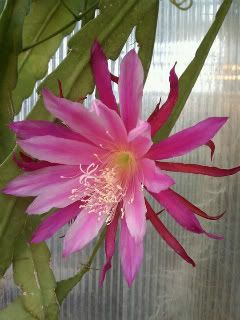Orchid Cactus

One of the most beautiful flowers you will find on a houseplant has to be the flower of the Epiphyllum, or Orchid Cactus, as it is commonly known. Epiphyllums are not related to orchids in any way, but their flowers are so lovely they rival some of the more attractive orchid blooms. Similar to orchids, the Orchid Cactus is an epiphyte in its natural environment, which should be taken into consideration when growing one at home.
 The Orchid Cactus prefers bright, but filtered sunlight. Indoors, this can be provided in a window that recieves direct sun most of the day, so long as the window has a sheer curtain. A window that gets sun in the afternoon would be another great place, and as this light is less intense than midday sun, a curtain is not needed. If you are able to place the plant outdoors during good weather, hanging it from a tree is a great option.
The Orchid Cactus prefers bright, but filtered sunlight. Indoors, this can be provided in a window that recieves direct sun most of the day, so long as the window has a sheer curtain. A window that gets sun in the afternoon would be another great place, and as this light is less intense than midday sun, a curtain is not needed. If you are able to place the plant outdoors during good weather, hanging it from a tree is a great option.
Epiphytes, such as these, are plants that grow without soil, often nestled within the branches of a tree. Debri that collects around the roots of the plant help to retain moisture and provide the nutrition the plant needs to grow and thrive. To recreate these conditions for an Orchid Cactus, you will need to modify its potting mix a bit. Standard potting soil is a bit too heavy and should be mixed with some additional perlite, though orchid bark, horticultural charcoal and coconut coir are also good.
Water your Orchid Cactus when the potting mix is almost completely dry. If the potting mix looks dry, lift the plant to test it's weight and dig in a finger a ways to feel for moisture. If you're not certain if it's dry enough to water, wait a day then check again. Try not to let the plant shrivel; that's a good indication its gone to long without water. Cut back watering dramatically during winter months. Established plants may not need any water at all, especially if given a cool place to rest such as a basement or garage. Temperatures should not go below 35 degrees Fahrenheit.
Propagation is typically done with cuttings, though hybridizing and propagation from seed can be fun for hobbyists. Cuttings should be allowed to callous over before they are placed in media, which takes about two weeks. Water cuttings very sparingly. To create a nice potted plant relatively quickly, I recommend placing several cuttings from the same plant together in a hanging basket.

Epiphytes, such as these, are plants that grow without soil, often nestled within the branches of a tree. Debri that collects around the roots of the plant help to retain moisture and provide the nutrition the plant needs to grow and thrive. To recreate these conditions for an Orchid Cactus, you will need to modify its potting mix a bit. Standard potting soil is a bit too heavy and should be mixed with some additional perlite, though orchid bark, horticultural charcoal and coconut coir are also good.
Water your Orchid Cactus when the potting mix is almost completely dry. If the potting mix looks dry, lift the plant to test it's weight and dig in a finger a ways to feel for moisture. If you're not certain if it's dry enough to water, wait a day then check again. Try not to let the plant shrivel; that's a good indication its gone to long without water. Cut back watering dramatically during winter months. Established plants may not need any water at all, especially if given a cool place to rest such as a basement or garage. Temperatures should not go below 35 degrees Fahrenheit.
Propagation is typically done with cuttings, though hybridizing and propagation from seed can be fun for hobbyists. Cuttings should be allowed to callous over before they are placed in media, which takes about two weeks. Water cuttings very sparingly. To create a nice potted plant relatively quickly, I recommend placing several cuttings from the same plant together in a hanging basket.
This site needs an editor - click to learn more!
You Should Also Read:
Christmas Cactus
Easter Cactus
Kalanchoe
Related Articles
Editor's Picks Articles
Top Ten Articles
Previous Features
Site Map
Content copyright © 2023 by Lisa Beth Voldeck. All rights reserved.
This content was written by Lisa Beth Voldeck. If you wish to use this content in any manner, you need written permission. Contact
BellaOnline Administration
for details.


